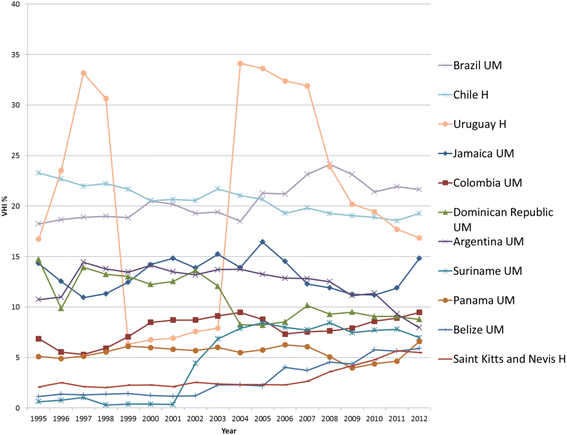Voluntary Health Insurance expenditure in low- and middle-income countries: Exploring trends during 1995-2012 and policy implications for progress towards universal health coverage
- PMID: 27089877
- PMCID: PMC4836104
- DOI: 10.1186/s12939-016-0353-5
Voluntary Health Insurance expenditure in low- and middle-income countries: Exploring trends during 1995-2012 and policy implications for progress towards universal health coverage
Abstract
Background: Most low- and middle-income countries (LMIC) rely significantly on private health expenditure in the form of out-of-pocket payments (OOP) and voluntary health insurance (VHI). This paper assesses VHI expenditure trends in LMIC and explores possible explanations. This illuminates challenges deriving from changes in VHI expenditure as countries aim to progress equitably towards universal health coverage (UHC).
Methods: Health expenditure data was retrieved from the WHO Global Health Expenditure Database to calculate VHI, OOP and general government health (GGHE) expenditure as a share of total health expenditure (THE) for the period of 1995-2012. A literature analysis offered potential reasons for trends in countries and regions.
Results: In 2012, VHI as a percentage of THE (abbreviated as VHI%) was below 1 % in 49 out of 138 LMIC. Twenty-seven countries had no or more than five years of data missing. VHI% ranged from 1 to 5 % in 39 LMIC and was above 5 % in 23 LMIC. There is an upwards average trend in VHI% across all regions. However, increases in VHI% cannot be consistently linked with OOP falling or being redirected into private prepayment. There are various countries which exhibit rising VHI alongside a rise in OOP and fall in GGHE, which is a less desirable path in order to equitably progress towards UHC.
Discussion and conclusion: Reasons for the VHI expenditure trends across LMIC include: external influences; government policies on the role of VHI and its regulation; and willingness and ability of the population to enrol in VHI schemes. Many countries have paid insufficient attention to the potentially risky role of VHI for equitable progress towards UHC. Expanding VHI markets bear the risk of increasing fragmentation and inequities. To avoid this, health financing strategies need to be clear regarding the role given to VHI on the path towards UHC.
Keywords: Health expenditure; Low- and middle-income countries; Private health insurance; Universal health coverage; Voluntary health insurance.
Figures












References
-
- WHO . Making fair choices on the path to universal health coverage: final report of the WHO consultative group on equity and universal health coverage. Geneva: World Health Organization; 2014. - PubMed
-
- Mossialos E, Thomson SM: Voluntary health insurance in the European Union. Funding health care: options for Europe 2004:128.
-
- Colombo F, Tapay N: Private health insurance in OECD countries: the benefits and costs for individuals and health systems. Towards High-Performing Health Systems: OECD working paper No 15. DELSA/ELSA/WD/HEA(2004)6.
-
- OECD . The OECD Health Project - Private Health Insurance in OECD Countries. Paris, France: Organisation for Economic Co-operation and Development; 2004.
MeSH terms
Grants and funding
LinkOut - more resources
Full Text Sources
Other Literature Sources
Medical

